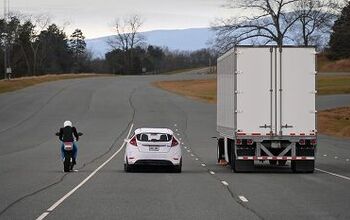GAO Rips DOE Fuel-Efficiency Loan Program
A new report [full PDF here] from the Government Accountability Office tears into the Department of Energy’s Advanced Technology Vehicle Manuacturing Loan (ATVML) program, the $25b “retooling loan” package that was the subject of TTAC’s first-ever Bailout Watch.
Although the loans represent about a third of the $25 billion authorized by law, the program has used 44 percent of the $7.5 billion allocated to pay credit subsidy costs, which is more than was initially anticipated. These higher credit subsidy costs were, in part, a reflection of the risky financial situation of the automotive industry at the time the loans were made. As a result of the higher credit subsidy costs, the program may be unable to loan the full $25 billion allowed by statute.
Well, no wonder GM pulled out of the program… it and Chrysler were asking for more than the remainder of $25b would have supported anyway, so if there is actually less than $25b to be spent, the high road away from the “Government Motors” image makes a lot more sense. But a lack of available funding isn’t the only problem with the program…
The report continues:
DOE has not developed sufficient performance measures that would enable it to fully assess the extent to which it has achieved its three program goals. For example, while DOE has a measure for assessing specifically the fuel economy gains for the vehicles produced under the program, the measure falls short of enabling assessment of progress in achieving DOE’s broad goal of improving the fuel economy of U.S. passenger vehicles as a whole because it does not account for, among other things, the fuel economy improvements manufacturers would have made, in the absence of the loans, to remain in compliance with increasingly strict federal fuel economy requirements. Principles of good governance call for performance measures tied to goals as a means of assessing the extent to which goals have been achieved.
Although the ATVM program has set procedures for overseeing the financial and technical performance of borrowers and has begun oversight, it has not yet engaged engineering expertise needed for technical oversight. To oversee financial performance, staff review data submitted by borrowers on their financial health to identify challenges to repaying the loans. Staff also rely on outside auditors to confirm whether funds have been used for allowable expenses. To oversee technical performance, ATVM staff analyze information borrowers report on their technical progress and are to use outside engineering expertise to supplement their analysis. According to our review, projects needing additional technical oversight are under way and the ATVM staff lack the engineering expertise called for by the program’s procedures for adequately overseeing technical aspects of the projects. However, the program has not yet engaged such expertise. As a result, DOE cannot beadequately assured that the projects will be delivered as agreed.
The GAO’s solution:
To help ensure the effectiveness and accountability of the ATVM program, we recommend that the Secretary of Energy direct the ATVM Program Office to take the following two actions: (1) accelerate efforts to engage sufficient engineering expertise to verify that borrowers are delivering projects as agreed and (2) develop sufficient and quantifiable performance measures for its three goals.
But apparently, this eminently sensible advice didn’t stick at Secretary Chu’s office
We provided a draft of this report to the Secretary of Energy or his designee for review and comment. In his comments, the Executive Director of DOE’s Loan Programs Office responded that he was pleased that we reported on the progress DOE has made in awarding loans that promise to deliver gains in fuel economy, but that DOE did not agree with either of our two recommendations.
DOE disagreed with our recommendation that the agency accelerate its efforts to engage sufficient engineering expertise to verify that borrowers are delivering projects as agreed. According to the Executive Director, the program will use engineering expertise to help monitor projects under certain circumstances, such as during the construction of manufacturing facilities. However, he explained in his comments that the projects for the four loans DOE has made to date are in the very early stages of engineering integration—at drafting tables and on computers—and therefore such expertise has not yet been required to monitor them. We disagree. That the work may be in its early stages does not diminish the need for independent engineering expertise. In fact, the ATVM program’s procedures state that engineering integration and construction activities require heightened technical monitoring, and, as DOE officials have previously told us, independent engineering expertise is an important aspect of such monitoring—particularly since ATVM staff expertise is largely financial, rather than technical. Moreover, three of the four loans have one or more projects that have been in the engineering integration phase for at least 10 months, and the other loan has at least one project that has begun construction—suggesting that DOE’s assessment of the projects’ status may not be up to date. By not engaging engineering
expertise to aid ATVM staff in monitoring the projects, DOE has not taken appropriate steps to become adequately informed about the technical progress of the projects. Thus, DOE cannot be assured that the projects are on track to deliver the vehicles as agreed nor be in a position to require the borrowers to make any corrections in a timely and efficient manner. We maintain that DOE should accelerate its efforts to engage sufficient engineering expertise for monitoring technical aspects of the projects as soon as possible.
DOE also disagreed with our recommendation to develop sufficient and quantifiable performance measures for its three ATVM program goals. In his comments, the Executive Director stated that the performance measures suggested by GAO would greatly expand the scope of the ATVM program and do not appear to be consistent with the intent of Congress in authorizing the program. However, he did not explain how measuring the performance of the program would expand its scope or be inconsistent with Congress’ intent beyond pointing out that measuring performance as we recommended would require research efforts by program staff and that Congress did not specify the performance measures. Principles of good government, as specified in the Government Performance and Results Act, require agencies to establish goals for their programs and performance measures that provide a basis for comparing program goals with the results.
DOE rightly established performance goals for the program, which are to (1) increase the fuel economy of U.S. passenger vehicles as a whole, (2) advance automotive technology in the United States, and (3) protect taxpayers’ financial interests. Furthermore, as we reported, DOE established two performance measures for its first goal—the extent to which the average fuel economy of ATVM-funded vehicles has increased over that of similar vehicles from model year 2005 and the extent to which the vehicles have consumed petroleum in comparison to similar vehicles from model year 2005. These performance measures fall short, in part, because they address only improvements at the program level and do not put those improvements into the broader context of total U.S. passenger vehicle fuel economy, which is necessary for assessing progress toward the national-level goal.
For example, DOE’s measure for assessing the petroleum saved by vehicles in the program provides a first step in determining whether the program is making progress toward its national-level goal of increasing fuel economy of U.S. passenger vehicles as a whole. However, to put DOE’s estimates of petroleum to be saved by program vehicles into the context of U.S. vehicles as a whole, DOE would need to determine such additional factors as (1) the extent to which program vehicles become part of the U.S. fleet as a whole, (2) the number of vehicles that the program vehicles replace, and (3) the number of miles the new vehicles are driven as compared with the miles driven by the vehicles they replace.
Furthermore, DOE’s two performance measures do not isolate the effects of the program from other factors. Although this can be difficult to do with precision, accounting for the effects of other factors could help the agency more accurately determine the effects of the program. We note in our report that, because automakers selling cars in the United States have to meet increasingly stringent CAFE targets, DOE could approximate the effects of the program by measuring the extent to which the ATVM-funded vehicles achieve fuel economy that surpasses those CAFE targets. However, in his comments, the Executive Director stated that DOE will not create new performance measures for any of its three program goals. By not setting sufficient performance measures for its three program goals, DOE is unable to assess its progress in accomplishing them. Assessing the extent to which the ATVM program is accomplishing its goals is particularly important given the current economic climate and constrained federal budget. DOE’s failure to develop and use appropriate performance measures means that Congress lacks important information on whether the funds spent so far are furthering the program’s goals and, consequently, whether the program warrants continued support. It also means that U.S. taxpayers do not know whether they are getting what they paid for through the loans.
Darn Government Accountability Office and its desire for accountability! Requesting technical assistance and clear goals is so unreasonable!
More by Edward Niedermeyer
Latest Car Reviews
Read moreLatest Product Reviews
Read moreRecent Comments
- EBFlex It will have exactly zero effect
- THX1136 What happened to the other companies that were going to build charging stations? Maybe I'm not remembering clearly OR maybe the money the government gave them hasn't been applied to building some at this point. Sincere question/no snark.
- VoGhost ChatGPT, Review the following article from Automotive News: and create an 800 word essay summarizing the content. Then re-write the essay from the perspective of an ExxonMobil public relations executive looking to encourage the use of petroleum. Ensure the essay has biases that reinforce the views of my audience of elderly white Trump-loving Americans with minimal education. Then write a headline for the essay that will anger this audience and encourage them to read the article and add their own thoughts in the comments. Then use the publish routine to publish the essay under “news blog” using Matt Posky listing the author to completely subvert the purpose of The Truth About Cars.
- VoGhost Your source is a Posky editorial? Yikes.
- Fed65767768 Nice find. Had one in the early-80s; loved it but rust got to it big time.Still can't wrap my head around $22.5K for this with 106,000 km and sundry issues.Reluctant (but easy) CP.

































Comments
Join the conversation
The logic behind the concept of extending loans for the development of greater fuel efficiency through retooling is sound, but such programs are in themselves an invitation to gamble with tax payer money without any risk to the borrower. Cash for Clunkers was another government program that was sour from the git go, and the unfortunate souls who participated found that out, the hard way. When GM and Chrysler were bailed out and/or nationalized, Ford received money under this DOE retooling guise, but most people with half a brain could recognize that this was just another type of bail out under a different name... because money is fungible! Money received from the DOE can be used anywhere, including in the development of the SVT Raptor, and no one at DOE would be the wiser. Is it any wonder why so many Americans have absolutely no faith in the government?
Fisker and Tesla are recipients of Section 136 loans (ATVM)...$528MM and $465MM respectively. Talk about gambling with taxpayer funds...